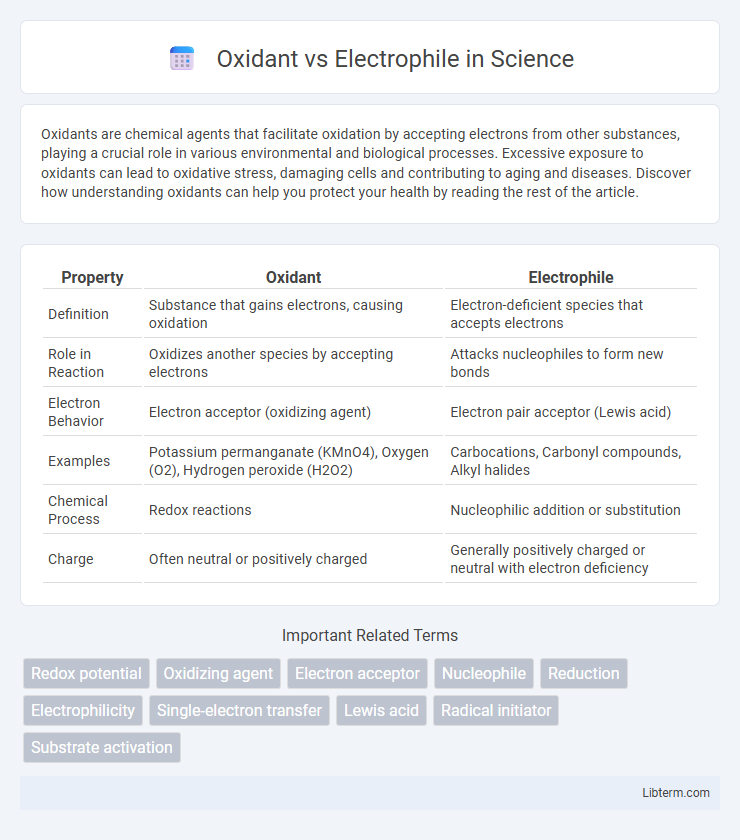Oxidants are chemical agents that facilitate oxidation by accepting electrons from other substances, playing a crucial role in various environmental and biological processes. Excessive exposure to oxidants can lead to oxidative stress, damaging cells and contributing to aging and diseases. Discover how understanding oxidants can help you protect your health by reading the rest of the article.
Table of Comparison
| Property | Oxidant | Electrophile |
|---|---|---|
| Definition | Substance that gains electrons, causing oxidation | Electron-deficient species that accepts electrons |
| Role in Reaction | Oxidizes another species by accepting electrons | Attacks nucleophiles to form new bonds |
| Electron Behavior | Electron acceptor (oxidizing agent) | Electron pair acceptor (Lewis acid) |
| Examples | Potassium permanganate (KMnO4), Oxygen (O2), Hydrogen peroxide (H2O2) | Carbocations, Carbonyl compounds, Alkyl halides |
| Chemical Process | Redox reactions | Nucleophilic addition or substitution |
| Charge | Often neutral or positively charged | Generally positively charged or neutral with electron deficiency |
Understanding Oxidants: Definition and Role
Oxidants are chemical agents capable of accepting electrons from other substances during redox reactions, causing oxidation by increasing the oxidation state of the reactant. They play a crucial role in various chemical and biological processes by facilitating electron transfer, which helps in energy production, synthesis of compounds, and degradation of pollutants. Unlike electrophiles that seek electron pairs to form bonds, oxidants specifically drive electron loss from substrates, enabling oxidation.
Electrophiles Explained: Core Concepts
Electrophiles are electron-deficient species that seek electrons to achieve a stable electronic configuration, often participating in chemical reactions as electron pair acceptors. They typically have vacant orbitals or a positive charge, making them highly reactive toward nucleophiles, which donate electrons. Understanding the electrophilic behavior is essential in organic chemistry for mechanisms involving substitution, addition, and other transformative reactions.
Key Differences Between Oxidants and Electrophiles
Oxidants are chemical species that accept electrons during redox reactions, increasing the oxidation state of other substances, whereas electrophiles are electron-deficient species that seek electron-rich sites to form chemical bonds. Key differences include their roles in reactions: oxidants facilitate electron transfer by undergoing reduction, while electrophiles participate in nucleophilic addition or substitution by attacking electron pairs. Oxidants often involve redox-active elements like oxygen or halogens, while electrophiles frequently contain positively polarized atoms such as carbonyl carbons or carbocations.
Chemical Properties: Oxidants vs Electrophiles
Oxidants are chemical species that accept electrons during redox reactions, often characterized by high oxidation states and strong electronegativity, enabling them to oxidize other substances. Electrophiles, by contrast, are electron-deficient atoms or molecules seeking electron pairs to form covalent bonds, typically containing positively polarized centers such as carbocations or molecules with polarized double bonds. While oxidants participate primarily in electron transfer processes, electrophiles are defined by their reactivity towards nucleophiles in bond-forming mechanisms.
Mechanisms of Action in Organic Reactions
Oxidants facilitate organic reactions by accepting electrons, often generating reactive intermediates such as radicals or carbocations through electron transfer processes. Electrophiles, characterized by electron deficiency, initiate reactions by attacking electron-rich nucleophiles, forming new covalent bonds via direct electrophilic addition or substitution mechanisms. Understanding the distinct electron flow--oxidants acting as electron acceptors and electrophiles as electron pair seekers--is crucial for predicting reaction pathways and intermediates in synthetic organic chemistry.
Common Examples of Oxidants and Electrophiles
Common oxidants include potassium permanganate (KMnO4), hydrogen peroxide (H2O2), and chromium trioxide (CrO3), which are widely used in oxidation reactions to accept electrons and increase the oxidation state of substrates. Typical electrophiles such as carbocations, acyl chlorides, and halogens actively seek electron pairs to form chemical bonds, playing a key role in nucleophilic substitution and addition reactions. Understanding the distinct roles of oxidants and electrophiles is crucial in organic synthesis, as oxidants primarily facilitate electron transfer while electrophiles engage in bond formation through electron pair acceptance.
Applications in Industrial and Laboratory Settings
Oxidants are widely used in industrial applications such as wastewater treatment, bleaching in paper manufacturing, and synthesis of pharmaceuticals due to their ability to accept electrons and facilitate oxidation reactions. Electrophiles play a crucial role in organic chemistry laboratories and industrial processes by targeting nucleophilic sites, enabling key reactions like electrophilic aromatic substitution and polymerization. Both reagents are essential in catalytic cycles and fine chemical production, where their reactivity profiles determine selectivity and efficiency in complex transformations.
Reactivity and Selectivity: A Comparative Analysis
Oxidants primarily engage in redox reactions by accepting electrons, exhibiting high reactivity with a broad range of substrates, often resulting in less selectivity due to their propensity to oxidize multiple functional groups. Electrophiles target electron-rich centers, showing enhanced selectivity through specific interactions with nucleophiles, which drives targeted chemical transformations. Reactivity in oxidants depends on their reduction potential, while electrophile reactivity and selectivity are governed by their electron deficiency and orbital interactions.
Safety Considerations for Handling
Oxidants and electrophiles both require strict safety measures due to their reactive nature, with oxidants posing risks of fire and explosion from their ability to release oxygen and intensify combustion. Electrophiles, characterized by their tendency to accept electrons, can cause severe chemical burns and require handling in well-ventilated environments using appropriate personal protective equipment (PPE) such as gloves and goggles. Proper storage away from incompatible substances, use of fume hoods, and immediate spill containment are critical to prevent hazardous exposure and chemical reactions.
Conclusion: Choosing the Right Reagent
Selecting the appropriate reagent depends on the specific reaction mechanism and desired outcome, as oxidants facilitate electron transfer by accepting electrons, while electrophiles seek electron-rich sites to form new bonds. Oxidants often drive redox reactions crucial for synthesis and degradation processes, whereas electrophiles are key in nucleophilic substitution and addition reactions. Understanding the substrate's electron density and reaction conditions ensures optimal reagent choice for efficient and selective chemical transformations.
Oxidant Infographic

 libterm.com
libterm.com